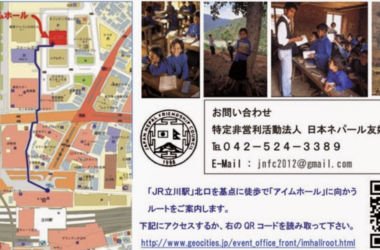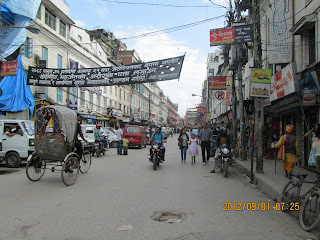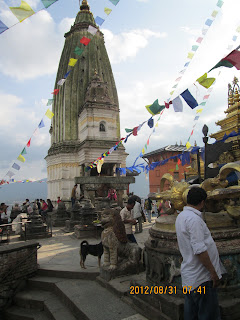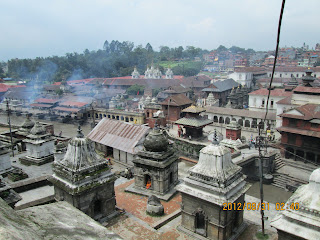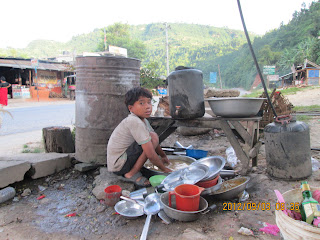I headed to Nepal to inspect and discuss the “Nepal Ropeway Project.”We will report below.(Hiroshi Nagano, Auditor, Japan-Nepal Friendship Association)
○Purpose: To contribute to the revitalization of the country’s economy and the development of infrastructure facilities by providing technical support to the projects of local private entrepreneurs.○Period: August 29th to September 7th, 2012
○Location: Sarankot (1600m above sea level), a small hill in Pokhara, GANDAKI district, in the western part of Nepal
○The origin of the plan: Considering the country of Nepal, and supporting the country’s industry The chairman of our association, who I know, requested Japan’s technical support for a project planned by “Fishtall View Cable Car Ltd.” run by Mr. Sharad, a local businessman, in order to make some progress in infrastructure projects. We have decided to provide technical cooperation in the hope that this will lead to an increase in the local tourism industry and employment.
○Plan Overview
Pokhara is a beautiful town with a lake (Phewa Tal) located over 200km west of the capital Katmandu.During the time of the kings, there was a villa of the royal palace, but now it has been nationalized and is open to the public as a park. . It has been compared to Akasaka and Roppongi in Japan, and many foreigners live here.Sarankot is a small hill on the mountain side, and when you climb to the top, you can see the lake directly below and the city of Pokhara next to it. On the other side, above your eye level, you can see the sharp white majesty of Machhapucha (6993m) and the Himalayas. It’s a wonderful view.This No. 1 project is to provide tourists with the opportunity to see this wonderful scenery by building equipment that will allow them to reach the summit from Pokhra town, a distance of approximately 3,400m, in approximately 12 minutes by ropeway. Pokhara receives about 700,000 foreign tourists annually. Since you can take a gondola (six-seater) to the top from town and see this wonderful view, we expect many people to visit.
Once these facilities are completed, there are plans for another No. 2 project: a monorail that will run from the airport, via the lake, through the city of Pokhara, and on to the Ropeway station.
○Schedule and Action
August 30th
0:20 Depart Haneda, → Arrive Bangkok at 4:50 Depart Bangkok
10:15 Depart Bangkok → Arrive Kathmandu at 12:25 14:00
Arrive at a hotel in Kathmandu city, and after a rest, meet Mr. Sharad. Have a meeting while eating. Cheers with momos (something like gyoza) and beer.
On August 31st,we had a one-day meeting with Mr. Sharad and other members (Mr. Yug, Mr. Dow) regarding the details of the plan.
On September 1st, Mr. Sharad and Mr. Dow visited Pashupatei Nath, a sacred Hindu site in Kathmandu, with the aim of getting to know Nepal well in order to smoothly proceed with this project. We were guided around Swayambhunath Temple, a temple and sacred place for Buddhism, and a temple where a living god resides.Of the 30 million people in Nepal, 80% are Hindus and Buddhists.
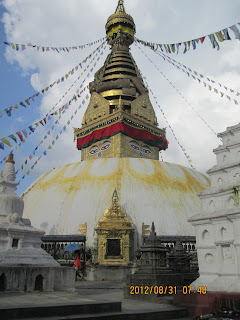
On the way back, we visited Mr. Sharad’s wife’s family home and had tea with her.His wife seemed to have been the president of the university until recently, and she was a wonderful person.
September 2nd:Moved from Kathmandu to Pokhara. Mr. Sharad, Mr. Dow, the driver, and I left Kathmandu before noon in a Mitsubishi jeep and arrived in Pokhara around 5 p.m. It took about 6 hours on the highway. I did.We immediately started researching Sarankot, and with the guidance of a local, we deviated from the originally planned course in the drawings and confirmed the first hill that would be reached if the course to the top was in a straight line, got off the mountain, and departed. Check point S1.
It gets dark and we return to the hotel. There was a power outage, so I ate dinner in the little light. The hotel was next to a lake and there were no lights in the town, so the surroundings were dark, so the stars looked very beautiful and large.
On September 3rd,I woke up at 5 a.m. to see the sunrise over Sarankot, drove to the top, and walked for about 20 minutes to reach the top. It was cloudy, but the sun had already risen. Locals and tourists were already here.Check out the entire course from the top. A flat green area of about 30m x 150m could be seen near the top. There is also an existing private house, but we plan to set up an arrival point (S3) to the left of this.
After surveying and taking photos for about 2 hours, we descended the mountain and moved on to investigate the river flowing at the base of Sarankot, which we could see from the summit. Roughly check the water volume at each point and check whether there is enough water volume for small hydropower generation. When deciding on the location, I decided to look a little further upstream next time.
After lunch at Sharad’s friend’s restaurant, we left Pokhara to see Nepal’s only existing ropeway on the way back to Katmandu.
We arrived at Manakamana Cable Car around 4pm. Ride the Ropeway to the top, visit the temple at the top, and then descend.
On the way, we took the necessary photos of the Ropeway and especially checked the level of finish on the base of the tower. The equipment specifications included a distance of 3km, 20 steel towers, 31 gondolas, a speed of 6m/s, a height difference of 1000m, and a transport capacity of 600 people/hour.
Arrived at the hotel around 7pm.
On September 4th, we made an appointment with Amod Manager of the local development bank (GURKHA DEVELOPMENT BANK (NEPAL) LTD.), where Mr. Sarad’s friend is in charge, and we both went to greet him. He explained his thoughts on this project in fluent English so quickly that I was able to understand the outline but could only catch about half of it.(I feel bad about my lack of language skills) In the afternoon, I went to Mr. Sharad’s company in the office district. It was a nice office, but the air conditioning wasn’t working due to the power outage, so it was hot.A young woman working at the office made us tea.
On September 5th,4 people, including Mr. Sharad, Mr. Yug, and Mr. Dow, were at the hotel. We discussed the results of this survey and our future schedule.We also discussed the hydrogen power generation technology that Mr. Yug is currently developing.When I returned to Japan, the three of them asked me when I would be coming next time. I answered that the basic plan will be ready in November.September6th,departed from Katmandu at 13:30, arrived at BANGKOK at 18:15, departed from BANGKOK at 22:10, arrived at TOKYO/NARITA. on September 7th , arrived at the airport.I got off at Shinyuri by bus and returned home around 10 o’clock.
○ Impressions about NEPAL
1) Nepal is a country that believes in and respects God, and has worshiped many gods since ancient times, and 80% of the people are Hindus and Buddhists. I heard that it is occupied by Many of them worship Buddha, and the gods who follow Shakamuni Buddha’s teachings have been passed down to Japan as the Five Great Tathagatas, and are said to be the embodiment of “nothingness.”Even if a cow was sitting in front of the hotel I was staying at, or a cow was blocking the road by eating grass on the highway, I was amazed at how people and cars still waited patiently until the cow moved. I did. This is how much the Japanese people value cows (gods?).I was surprised to see so many people in the streets of Kathmandu. And although they don’t act as busy as Japanese people (because they don’t have work), I felt they had a very young vitality and great power. That vibrant energy that makes you feel like something is about to happen!
2) Due to power shortages in Nepal, electricity is only available for about 8 hours a day, and it seems that electricity is contracted with the power company during the hours when it can be used effectively. A large hotel in Kathmandu has its own power generation equipment, and automatically switches to in-house power generation during the contracted power outage hours in the morning and evening.At night, hotels in Pokhara use rechargeable lamps that have been charged during the daytime power supply to provide lighting, and when the electricity runs out, they switch to candles. Candles are always available. We went out on the lawn in the garden, sipped tea with candles on the table, and enjoyed the beautiful stars shining in the night sky. You don’t even need a candle, just the light of the moon.I was able to experience a wonderful space in the darkness with no artificial lighting, which I can’t experience in Japan, with only the moon and stars as the light.While looking at the stars, I suddenly thought that if it were the general will of Japan’s people to phase out nuclear power, they would not have to go as far as Nepal to reduce electricity consumption by 60% as a measure against power shortages. In any case, I think we need to be aware that we have an obligation to endure some inconvenience in life by being prepared to save up to 20-30%.This is what I felt when I went to Nepal this time
